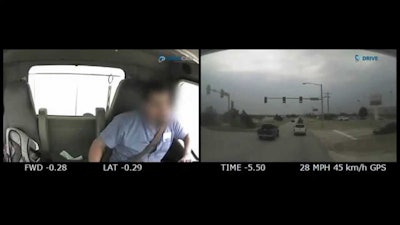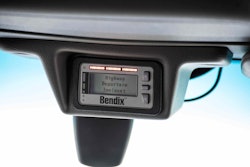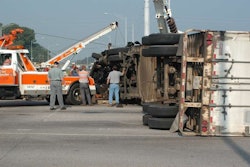 Driver- and road-facing event recorders are one of the National Transportation Safety Board’s top 10 most wanted safety improvements for 2017.
Driver- and road-facing event recorders are one of the National Transportation Safety Board’s top 10 most wanted safety improvements for 2017.Seven of the National Transportation Safety Board’s 10 “most wanted” transportation safety improvements could have an impact on truckers and the trucking industry.
NTSB’s annual Most Wanted List, released this week, outlines the top 10 improvements the government agency would like to see over the next year. The NTSB, however, has no regulatory power, and its job is to recommend to regulators ways to prevent crashes and deadly accidents in all modes of transportation. This year’s list moves to a two-year cycle instead of the annual cycle for the report, NTSB says, to allow more time for changes to be made to address the issues on the list.
The seven recommendations on NTSB’s 2017-2018 most wanted list related to trucking include:
 Collision avoidance systems remain one of NTSB’s most wanted safety improvements.
Collision avoidance systems remain one of NTSB’s most wanted safety improvements.Increase implementation of collision avoidance technologies
NTSB says driver error is the biggest factor in crashes with data from the National Highway Traffic Safety Administration showing 94 percent of crashes are the fault of drivers.
For commercial vehicles, NTSB recommends NHTSA develop performance standards for collision avoidance systems and encourages fleets and truck drivers to install these technologies before regulations are made.
At a minimum, NTSB recommends forward collision warning systems be installed in trucks. Autonomous emergency braking and lane departure warning systems are also technologies NTSB says will help reduce crashes.
Expand recorder use to enhance safety
NTSB says event data recorders can capture critical information about the vehicle and the occupants for the seconds leading up to, during and after a crash, as well as whether the brakes were applied, the speed of the vehicle and more.
Because of the benefits event recorders can provide for investigators after a crash, NTSB recommends regulators require their use and mandate that companies use the data in their safety management programs.
The agency encourages NHTSA to develop standards and require the use of event data recorders in heavy-duty vehicles and also encourages FMCSA to require all heavy commercial vehicles be equipped with video event recorders to capture both the driver and the outside environment at the time of a crash.
“Motor carriers should be required to review and use video event recorder information in conjunction with other performance data to verify that driver actions are in accordance with company and regulatory safety rules and procedures,” NTSB says.
Additionally, the agency says trucking companies and drivers shouldn’t wait on regulations, but should be proactive and install these recorders before regulations require them.
End alcohol and other drug impairment
The agency says alcohol and drug impairment continues to contribute to transportation fatalities. The Board says marijuana decriminalization, synthetic drug use and a rise in over-the-counter drug abuse compound the problem.
NTSB recommends passing and enforcing laws and educating the public to end impairment in transportation. The agency says every transportation death caused by alcohol and drugs is preventable.
Reduce fatigue-related accidents
The agency says it has issued more than 200 safety recommendations addressing fatigue-related problems across all modes of transportation. To address the problem of fatigue in transportation, NTSB says it will require “a comprehensive approach that focuses on research, education and training, technology, treatment of sleep disorders, hours-of-service regulations, and on- and off-duty scheduling policies and practices.”
Additionally, NTSB says the Federal Motor Carrier Safety Administration’s electronic logging device mandate is a step in the right direction because it will require truckers to adhere to hours-of-service regulations and “reduce the risk of fatigue-related commercial motor vehicle crashes.”
Require medical fitness
NTSB says it’s important for drivers to live healthy lifestyles and keep their medical examiners informed of health conditions that could affect their ability to drive safely. Additionally, the agency says that while FMCSA requires training and certification for medical examiners, there’s no mechanism in place to make sure they’re following the recommended guidelines.
The agency recommends a comprehensive medical certification system for drivers that includes a driver’s complete medical history; procedures to identify applicants at high risk for sleep disorders; identification of specific conditions, treatments and medications that initially disqualify applicants for duty; certificates that are good for only a limited time; examiners who are licensed to perform exams and prescribe medications and more. A full list of medical recommendations can be seen here.
NTSB says its goal is to ensure drivers are medically fit for duty before they operate a vehicle.
Eliminate distractions
NTSB says more than 35,000 people were killed on U.S. highways in 2015, and an estimated 1 in 10 of those deaths were because of distracted driving. In order to reduce crashes, injuries and deaths, NTSB says drivers have to disconnect completely from all distractions, including phones and other portable devices.
In order to combat distracted driving, NTSB is urging all states to expand and strengthen distracted driving laws. Four states – Arizona, Texas, Montana and Missouri – don’t have anti-texting laws yet, and only 14 states and the District of Columbia ban handheld devices while driving.
Strengthen occupant protection
More than half of the people killed on American highways last year were unrestrained, NTSB says, even though seat belts and other restraints have been required in most states for more than 20 years.
To combat this problem, the agency says strong occupant restraint laws are critical. Additionally, NTSB calls for better enforcement of the laws in places, as well as education campaigns about the benefits of seat belt use.














